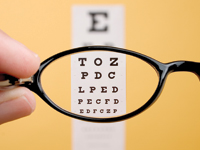Routine Eye Exams
 Comprehensive eye examinations should be a regular part of every person's healthcare routine. They are an important tool in eye health by detecting and preventing eye diseases and evaluating the overall health of the patient. Some diseases, such as glaucoma, develop gradually without symptoms of pain or vision loss, so patients may not notice that anything is wrong until significant and irreversible damage has been done. Early detection of eye diseases allows for a choice of treatment options and a reduced risk of permanent damage.
Comprehensive eye examinations should be a regular part of every person's healthcare routine. They are an important tool in eye health by detecting and preventing eye diseases and evaluating the overall health of the patient. Some diseases, such as glaucoma, develop gradually without symptoms of pain or vision loss, so patients may not notice that anything is wrong until significant and irreversible damage has been done. Early detection of eye diseases allows for a choice of treatment options and a reduced risk of permanent damage.
Our practice tests vision and provides prescriptions for eyeglasses and contact lenses when necessary. We use state-of-the-art equipment and techniques to evaluate and maintain your overall eye health.
A regular eye examination encompasses comprehensive testing for the early detection of a range of problems including:
- Cataracts
- Glaucoma
- Dry eye
- Macular degeneration
- Diabetic retinopathy
- Corneal disease
If any eye health issues are detected, an individualized treatment program will be designed to address the condition or prevent it from progressing.
Eyeglasses & Contact Lenses
 Over 150 million people in the United States wear eyeglasses or contact lenses. Glasses and contact lenses improve vision by adjusting the way the eyes bend and focus light. Ideally, light rays are refracted, or bent, as they pass through the cornea so that the image can be focused on the retina, in the back of the eye. In a healthy eye, this means that objects can be seen clearly. Many people have a cornea that has either a shallow or steep curvature that causes light rays to focus either in front of or behind the retina. Objects may appear blurry at certain distances or at all distances.
Over 150 million people in the United States wear eyeglasses or contact lenses. Glasses and contact lenses improve vision by adjusting the way the eyes bend and focus light. Ideally, light rays are refracted, or bent, as they pass through the cornea so that the image can be focused on the retina, in the back of the eye. In a healthy eye, this means that objects can be seen clearly. Many people have a cornea that has either a shallow or steep curvature that causes light rays to focus either in front of or behind the retina. Objects may appear blurry at certain distances or at all distances.
Glasses and contact lenses correct these refractive errors. Prescriptions for each eye are measured for optimal vision clarity, usually 20/20. Eyewear may be used for certain activities, such as reading for farsighted, or hyperopic patients and driving or watching television for nearsighted, or myopic patients. Eyeglasses or contact may be need to be worn at all times.
Regular eye exams test for the development and progression of refractive errors and help your doctor provide a proper prescription if eyeglasses or contact lenses are needed. Exams are also an invaluable tool in the early detection of eye disease.
Diabetic Eye Care
 Patients with diabetes are at an increased risk of developing eye diseases that can lead to vision loss and blindness, such as diabetic retinopathy, cataracts and glaucoma. In fact, diabetic retinopathy is the leading cause of blindness in the United States.
Patients with diabetes are at an increased risk of developing eye diseases that can lead to vision loss and blindness, such as diabetic retinopathy, cataracts and glaucoma. In fact, diabetic retinopathy is the leading cause of blindness in the United States.
Diabetic eye conditions often develop without any noticeable vision loss or pain, so significant damage may already occurred to the eye by the time patients notice any symptoms. For this reason, it is important for diabetic patients to have their eyes examined at least once a year. Early detection of eye disease can help prevent permanent damage.
Diabetic-related eye problems develop from high blood sugar levels, which can cause damage to blood vessels in the eye. More than 40 percent of patients with diabetes will develop some form of eye disease in their lifetime. The risk of developing eye problems can be reduced through regular eye exams and by keeping blood sugar levels under control through a healthy diet and regular exercise.
Causes of Diabetic Eye Conditions
Diabetic eye conditions develop in the retina as a result of microvascular abnormalities. The tiny blood vessels within the retina develop microaneurysms and begin to leak blood. As new blood vessels develop to replace the blood vessels that are no longer viable, they also leak blood and can cause hemorrhages and permanent damage to the retina.
While diabetics struggle with a high sugar count in the blood along with insufficient insulin production, it is actually the lack of oxygen in the blood that causes eye problems and leads to vision loss.
Diagnosis of Diabetic Eye Conditions
Diabetic eye conditions can be detected through a comprehensive eye exam. A comprehensive eye exam involves a visual acuity test to measure vision at various distances, and a dilated eye exam to examine the structures of the eye for any signs of disease. During this test, your doctor can examine the retina and optic nerve with a special magnifying lens. Tonometry may also be performed during a comprehensive eye exam to measure the pressure inside the eye with a special instrument.
Eye exams should be performed at least once a year or as soon as any potential problems are detected in order to ensure the early detection of any serious conditions. Early detection is the strongest protection against diabetic eye diseases.
